BUDDHIST PILGRIMAGE TO INDIA AND NEPAL
“In the Master’s Footsteps” 24 Nov - 5 Dec 2014 (12D/11N)

At Gijjhakuta Hill top (Vulture Peak) Rajgir.
Day 4 (27.11.2014) - Gijjhakuta Hill (Vulture Peak) and Nalanda
The hotel morning call at 4am and be at the lobby at 4.45am. At 5am the bus took us to Gijjhakuta Hill (Vulture Peak) for chanting and meditation and also for the sunrise view. The Gijjhakuta hill (Vulture Peak) was the seat from where the Buddha delivered many of the sermons. It was here that the teachings of the Buddha were recorded in writing for the first time.
At 7.30am we depart Vulture Peak to go back to hotel for breakfast and at 9.00am we departed hotel to visit the Bimbisara Jail and the Sonebhandar (treasury). At 10am we departed Sonebhandar to go back to hotel for the 11.30am Dana to 10 monks from 5 countries.
In the afternoon at 2pm we departed hotel for Nalanda to visit the Nava Nalanda Mahavihara (Deemed University). Later we visited The Ruins of Nalanda, Archaeological Museum and the Xuan Zang Memorial Hall.
Breakfast / Lunch / Dinner and overnight at Hotel Rajgir Residency
A large orb taken by Julie Tan Chooi Kee at Gijjhakuta hill top (Vulture Peak). If you enlarge this photo you could see the lights inside it.
Gijjhakuta hill (Vulture Peak) was the favourite resort of the Buddha and the scene of many important discourses while he was in Rajgir.
To reach at Gijjhakuta hill top (Vulture Peak), is to climb up a long stone stairway, 6.1m to 7.3m wide, called the Bimbisara road, built by the King to enable him to reach the summit to see the Buddha.
Recently, a cement staircase has been constructed to facilitate pilgrims climb to Gijjhakuta hill top, which is a flat terrace surrounded by a low retaining wall with a shrine near the precipice.
A place for pilgrims to perform puja and reciting virtues of Buddha at Gijjhakuta hill top (Vulture Peak).
In deep meditation at Gijjhakuta hill top (Vulture Peak).
at Gijjhakuta hill top (Vulture Peak).
Ching Neng Bin at Gijjhakuta hill top (Vulture Peak).
Even the hill monkeys came to view the sunrise at Gijjhakuta hill top (Vulture Peak).
At the summit, one can see the huge granite rock formation resembling 2 vultures standing with folded wing, from which the hill derived its name at Gijjhakuta hill top (Vulture Peak).
The hill monkeys at Gijjhakuta hill top (Vulture Peak).
Stome House - These two caves may represent the stone houses on the Gridhrauta Hill seen by the Chinese pilgrim.
The rocky path ends near the top of Gijjhakuta hill top (Vulture Peak) where one can see two natural caves, which were probably used by the Buddha and Ven. Ananda. Near the bottom of the cement staircase are two smaller caves believed to be used by Ven. Sariputta and Ven. Moggallana.
Gijjhakuta hill top has two natural caves, which were probably used by the Buddha and Ven. Ananda.
Gijjhakuta hill top has two natural caves, which were probably used by the Buddha and Ven. Ananda.
This spot at Gijjhakuta hill offers a commanding view of the valley below.
Jivaka’s mango garden (Jivaka ambavana) - According to Pali sources, Jivaka’s mango garden is situated between the city’s East Gate and Gijjhakuta, and the site has been identified a short distance from the foot of Gijjhakuta. According to the Vinaya Texts, Jivaka Komarabhacca was the adopted son of Prince Abhaya, who found him alive (jivati) in a dust heap when he was an infant and raised him up. When he was old enough, he set out for Taxila to study medicine for seven years. To test his knowledge, his teacher asked him to go all round Taxila to search for any plant, which was not medicinal and bring it back. Jivaka proved to be so proficient in medicinal plants that he returned after a long search and declared that he had not seen any plant that was not medicinal within a yojana (13km) of Taxila.
Returning to Rajgir, he cured many people suffering from serious ailments and even performed surgery, something unheard of in those days. He became the leading physician and surgeon of Rajgir and earned great wealth through his medical practice. At some point in his career, he became a lay disciple and used to attend on the Buddha three times a day. When the Buddha’s foot was injured by a splinter from a rock hurled by Devadatta, it was Jivaka who attended on him and healed the wound. Realizing the advantages of having a monastery near his home, Jivaka built one on his extensive mango garden and donated it to the Buddha. The site of this monastery was excavated recently, which exposed the buried foundations of elliptical buildings, possibly of monastic nature, of an early date.
Bimbisar Jail, Rajgir is a tourist destination featuring the remains of a historic jail amid scenic landscape.
Bimbisara Jail - About 2½ km south of Veluvana beside the main road, is an area about 60m square enclosed by the remains of a stone wall 2m thick. This area has been identified as the prison in which Bimbisara was jailed by his son Ajatasattu, who usurped the throne. It is said that from this prison, the king could see the Buddha up in Gijjhakuta, the sight of whom provided great joy to the prisoner.
As seen from Bimbisara Jail, Vulture peak is on the Gijjhakuta hill at the distance.
The Son Bhandar or Sonebhandar caves are two artificial caves located in Rajgir in the state of Bihar.
One of the most interesting and mysterious ones is SoneBhandar Caves – two rock-cut caves located close together at the southern foot of Vaibhar Hill. Both caves seem to be hollowed in the cliff in 3rd - 4th century AD – at least inscription inside the western cave, between the door and window tells that it was done by the Great Saint of Jains – Muni Vairadevi for Jain ascetics in this time. 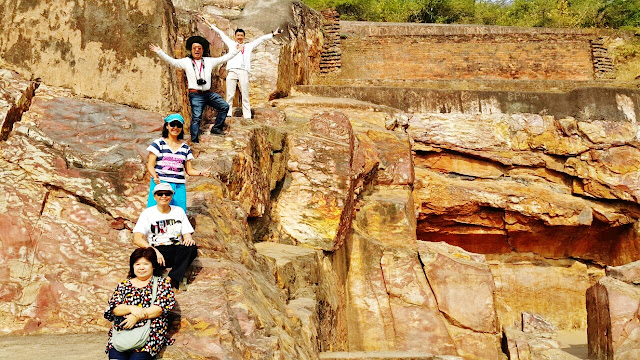
Sonebhandar caves are two rock-cut caves located close together at the southern foot of Vaibhar Hill.
Eastern Sonebhandar cave is partly ruined and the front part of cave chamber has fallen. 
Sonebhandar upper floor above the cliff made in brick is added later, during Gupta period and possibly caused the collapse of front wall of the cave. Most likely also this cave had verandah in front. 
Southern Sonebhandar cave wall contains important early Jain artwork – exquisitely sculpted small reliefs of six Jain Tirthankaras – Padmaprabh, Parsvanath, Mahavira and others.
This relief seems to be added later, sometime after the completion of Sonebhandar caves, it shows little congruity with the plan of rock-chamber.
It is the western Sonebhandar cave which gave the name to monument: SoneBhandar means "store of gold" and legend about this treasure is linked to western cave. The cave believed to be a guard cave contains single rectangular chamber, 10.4 x 5.2m large. The vaulted ceiling stands on vertical walls, vault rises up to 1.5m high. This resembles the style of older Mauryan rock-cut sanctuaries. In ancient times most likely there was a roofed verandah in the front of caves. 
Robert Chong Wei Kuen and Ching Neng Bin at the window of western Sonebhandar cave in Rajgir.
Local legend tells that this Sonebhandar cave still hides a passage to the treasury of gold – entrance in this passage is well hidden in the cave chamber behind an ancient stone wedge. Some also believe that the passage goes through Vaibhargiri Mountain and reaches Saptaparni Caves on the other side of range.
Some believe that this Sonebhandar cave treasure belongs to Jarasandha, others – that to Bimbisara. In a case of Bimbisara legend goes that when Ajatashatru confined his father Bimbisara (remnants of this prison are nearby), his mother secretly hid some wealth and later donated it to Tirthankar.
In the wall of Sonebhandar cave there is seen a trace of carving, resembling a doorway and next to it – an undeciphered inscription in Sankhlipi writing or shell script. When I shot this picture, I noticed the orb on the top right side corner and when I shot again (photo below) the orb was gone. Does any one believe in orbs?
Sonebhandar cave - It is believed that this inscription is a password – who will read it, will open the door and enter the passage. This ornate script has been found in India as well as in Java and Borneo and never been deciphered. There is also a black mark above or in the upper part of the mysterious doorway left by cannonball when Brits tried (without success) to break the wall and enter the passage.
A horse cart on the road near to Sonebhandar cave.
We came back to Rajgir Residency hotel for the 11.30am Dana offering to ten monks from five countries. 
Dana offering to ten monks from five countries at Rajgir Residency hotel.
Dana offering to ten monks from five countries at Rajgir Residency hotel.
Dana offering to ten monks from five countries at Rajgir Residency hotel.
Dana offering to ten monks from five countries at Rajgir Residency hotel.
Dana offering to ten monks from five countries at Rajgir Residency hotel.
In the early 1950's, in order to revive the lost glory and the heritage of ancient Nalanda Mahavihara, his Excellency Dr. Rajendra Prasad, the first President of the Republic of India, declared that the ancient seat of Buddhist learning at Nalanda would be revived.
At the insistence of Ven. Bhikshu Jagdish Kashyap (1908-1976) and with this goal in mind, the Government of Bihar established a research institute called "Magadh Institute of Post-Graduate Studies and Research in Pali and Allied Languages and Buddhist Learning" at Nalanda in 1951. It later came to be known as Nava Nalanda Mahavihara.
An archaeologist at Nalanda University run us through the excavation of the ruins in Bihar, India and he was very excited because of some latest discoveries. 
The trails of Faxian and Xuanzang to India.
An archaeologist at Nalanda University run us through the excavation of the ruins in Bihar, India.
An archaeologist at Nalanda University run us through the excavation of the ruins in Bihar, India.
An archaeologist at Nalanda University run us through the excavation of the ruins in Bihar, India.
An archaeologist at Nalanda University run us through the excavation of the ruins in Bihar, India.
An archaeologist at Nalanda University run us through the excavation of the ruins in Bihar, India.
An archaeologist at Nalanda University run us through the excavation of the ruins in Bihar, India.
A talk presented by Dr. Ravindra Panth the Nalanda University Director.
A talk presented by Dr. Ravindra Panth the Nalanda University Director.
Dr. Ravindra Panth the Nalanda University Director presented some booklets and a plaque to our group leader Datuk Seri Dr. Victor Wee.
In April 2000, Dr. Ravindra Panth was appointed Nalanda University Director. After his joining, he geared up all round activities of the Mahavihara like Infrastructure, teaching, seminars, conferences and workshops, etc. With the effort of Dr. Panth the Mahavihara got the Deemed University status on 13th November, 2006 with the notification No. F. 9-38/2004-U.3 (A) by the Government of India.
A colourful convenience store by the roadside near to Nalanda University.
The ruins of Nalanda was a Buddhist monastic university in ancient Magadha (modern-day Bihar) India.
The ruins of Nalanda was a Buddhist monastic university in ancient Magadha (modern-day Bihar) India.
The excavated ruins of Nalanda Mahavihara. 
The ruins of Nalanda Mahavihara were first excavated in 1871 by Sir Alexander Cunningham who identified its site at the modern village of Bargaon on the basis of the accounts of the Chinese pilgrim, Hsüan Tsang. Located only 12km from Rajgir, he ruins extend over a vast area. The structures exposed represent only a part of the vast establishment and consist of monastic sites, stupa sites and temple sites.
The ruins of Nalanda Mahavihara extend from south to north, the monasteries on the eastern flank and temples on the west. The monasteries were all built on more or less the same plan and to-date, at least eleven monastic sites and five main temple sites have been identified.
The ruins of Nalanda Mahavihara.
Nalanda flourished under the patronage of the Gupta Empire as well as emperors like Harsha and later, the rulers of the Pala Empire. At its peak, the school attracted scholars and students from as far away as Tibet, China, Korea, and Central Asia. It was ransacked and destroyed by an army of the Muslim Mamluk Dynasty under Bakhtiyar Khilji in c. 1197 CE.
The ruins of Nalanda Mahavihara.
The ruins of Nalanda Mahavihara, Monastery No.01.
The ruins of Nalanda Mahavihara.
Evidence in literature suggests that in c. 1197 CE Nalanda was ransacked by Bakhtiyar Khilji, a Turk. The Persian historian Minhaj-i-Siraj, in his chronicle the Tabaqat-i-Nasiri, reported that thousands of monks were burned alive and thousands beheaded as Khilji tried his best to uproot Buddhism. The burning of the library continued for several months and "smoke from the burning manuscripts hung for days like a dark pall over the low hills."
The ruins of Nalanda Mahavihara.
The ruins of Nalanda Mahavihara.
The ruins of Nalanda Mahavihara.
On the left side is a teaching platform in the ruins of Nalanda Mahavihara.
The ruins of Nalanda Mahavihara.
The ruins of Nalanda Mahavihara.
The ruins of Nalanda Mahavihara.
The school children gathered around the well in the center of Nalanda.
This holes in the kitchen are for the cooking pots in the center of Nalanda.
The ruins of Nalanda Mahavihara.
The most prominent standing structure at Nalanda is the Sariputta stupa, erected in honour of the Chief Disciple, who was born and passed away in the nearby village of Nalaka.
The remnants of the library of Nalanda, which is reported to have burned for three months after the invaders set fire to it, ransacked and destroyed the monasteries, and drove the monks from the site by Muhammad Bakhtiyar Khilji who was a Turkic military general of Qutb-ud-din Aybak.
Established in 1971, the Nalanda archeological museum is situated in front of the ruins of the famous ancient learning centre of Nalanda. The archaeological museum of Nalanda (Bihar) possesses the treasures of Buddhism in the form of stuffs related to the Buddha. The museum has a rare and beautiful collection of Buddha's bronze statues, copper plates, manuscripts, stone inscriptions, pottery, coins and images of Hindu Gods and Goddesses. With two terracotta jars or pots (1st century CE) standing just behind the museum, the place also owns unique samples of burnt rice, which dates back to the 12th century CE.
The large bell at archaeological museum of Nalanda (Bihar).
The Xuanzang Memorial Hall in India.
The Xuanzang Memorial Hall is an Indo-Chinese undertaking to honour the famed Buddhist monk and traveler. A relic, comprising a skull bone of the Chinese monk, is on display in the memorial hall.
The Xuanzang Memorial Hall is an Indo-Chinese undertaking to honour the famed Buddhist monk and traveler. 
The trails of Faxian and Xuanzang to India. 
The trails of Faxian and Xuanzang to India. 
A photo shoot at The Xuanzang Memorial Hall.
Nava Nalanda Mahavihara, Nalanda is particularly thankful to the Ministry of Culture, Government of India, the Government and the people of China, and various Buddhist organizations for supporting this noble project. The Xuanzang Memorial symbolizes the age-old ties between the two great civilizations of India and China and is a befitting tribute to Indo-China friendship. The essential components of the creative works to shape it in a Memorial Museum were carried out subsequently.
Ven. Bhikkhu Jagadish Kashyap, the founder Director of Nava Nalanda Mahavihara first proposed the establishment of a Memorial Hall as a symbol of Indo-China friendship dedicated to the great Monk, scholar Ven Xuanzang to pay homage to his spirit of freedom and quest for knowledge, and also, to strengthen the friendship between India and China. With the help of Pandit Jawaharlal Nehru, India's first Prime Minister and Chinese Premier Zhou Enlai, work for the establishment of the Xuanzang Memorial Hall was initiated in January 1957. The Government of India received the relics of Ven. Xuanzang along with an endowment for the construction of the XuanzangMemorial Hall and some Chinese Buddhist texts, from the Chinese Government at a function at Nava Nalanda Mahavihara, Nalanda. The construction of Xuanzang Memorial Hall was completed in 1984.
The beautiful paintings and designs on the wall of Xuanzang Memorial Hall.
The beautiful paintings and designs on the ceiling of Xuanzang Memorial Hall.
An evening tea hosted by Dr. Ravindra Panth at Xuanzang Memorial Hall garden.
Dr. Ravindra Panth presented a souvenir to Datuk Seri Dr. Victor Wee at Xuanzang Memorial Hall garden.
Day 01 (24.11.2014) Kuala Lumpur to Bangkok to Bodhgaya, India
Day 02 (25.11.2014) Bodhgaya to Dungeswari Cave - Sujata Stupa - Bodhgaya
Day 03 (26.11.2014) Bodhgaya to Rajgir by coach (80km, 3 hrs drive)
Day 04 (27.11.2014) Rajgir to Gijjhakuta Hill (Vulture Peak) - Nalanda - Rajgir
Day 05 (28.11.2014) Rajgir to Vaishali by coach (130km, 5 hrs drive)
Day 06 (29.11.2014) Vaishali to Kushinagar by coach (180km, 6hrs drive)
Day 07 (30.11.2014) Kushinagar to Lumbini by coach (160km, 7hrs drive)
Day 08 (01.12.2014) Lumbini in, Nepal
Day 09 (02.12.2014) Lumbini to Sravasti by coach (250Km, 8hrs drive)
Day 10 (03.12.2014) Sravasti to Varanasi by coach (270Km, 11 hrs. drive)
Day 11 (04.12.2014) Varanasi to Sarnath. Varanasi to Bangkok TG328 16:30hrs 21:15hrs
Day 12 (05.12.2014) Bangkok to Kuala Lumpur
///

















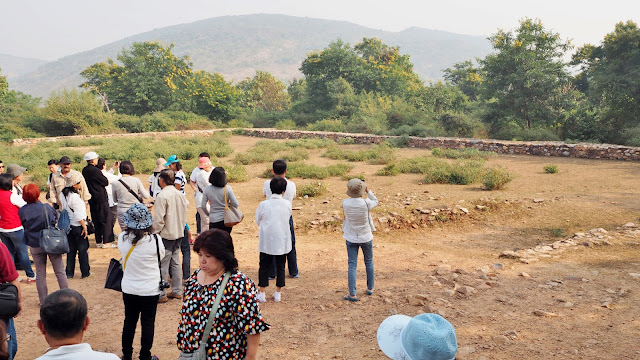











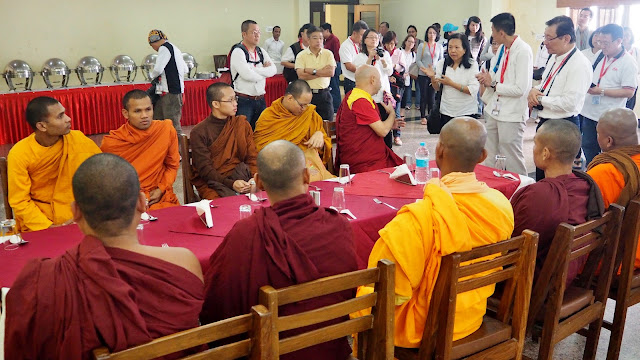

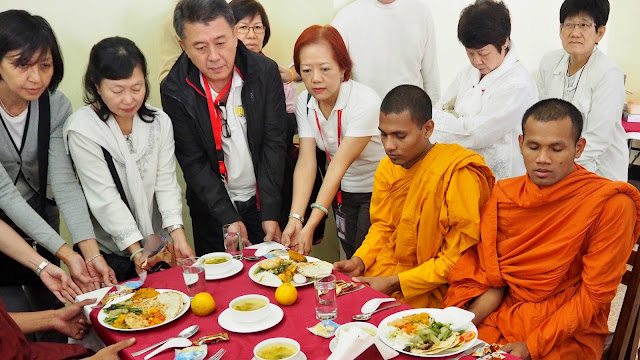

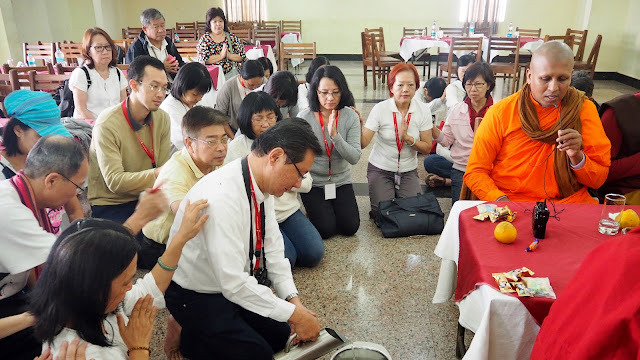

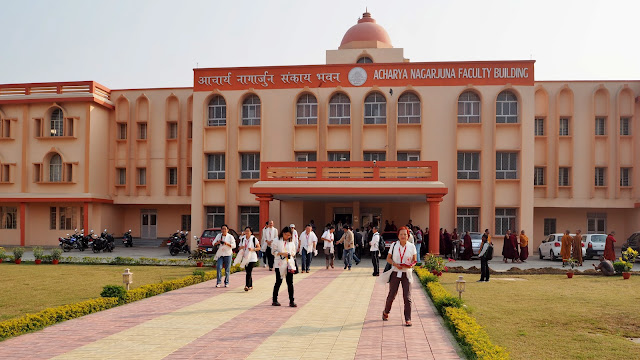








































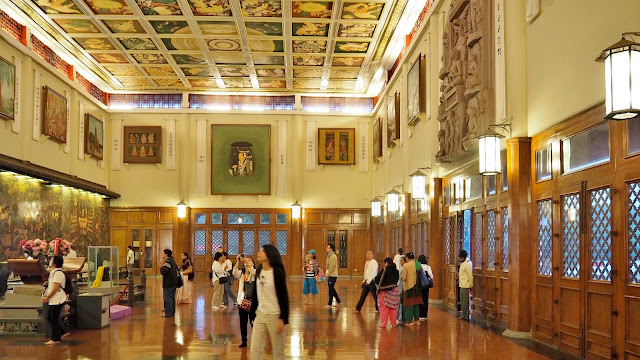





Hi Neng Bin, I noticed that Victor Wee was the group leader. I have known him before he was a Datuk Seri Dr Victor Wee! He was then a plain Victor Wee! I haven't seen him for a very long time. I last met him when he was with Tourism Malaysia!
ReplyDeleteThank you for the detailed journey. Learned so much from your trips. Keep them coming! Wishing you A Healthy and Abundant Year ahead.
ReplyDeletePoh Lean
Thank you Neng Bin for a most beautiful write-up with colourful pictures of our pilgrimage, it is really memorable. Sadhu Sadhu Sadhu to you!
ReplyDeleteMemorable travels that folowed the trails of The Rev.Faxian and Rev.Xuanzang in the 7th Century AD. Very captivating and interesting read for followers of NB Ching's expeditions. I understand that Dr Victor Wee is the retired Secreatary General of Tourism Ministry (Tell me if I'm wrong). Under his leadership of your tour group, I'm sure lots of information and details had been worked out before the journey began with his vast experience and expertise. (My tour guiding licence for many years bore his signature). I'm sure Ching had contributed much in preparing for the soul searching trip.The appearance of orbs in pictures taken were intriguing and puzzling. It's rather mysterious. More research in reading materials regarding this phenomenon should be carried out. It's quite peculiar and there must be reasons for its surfacing on photos taken. I'm more interested in the geographical, archeological and historical features of your reports in this pilgrimage. Thanks, NB Ching, you're making a sustainable name in the net as a writer traveler that entices tourists to follow your styles and trails. Regards, Alan Kok
ReplyDeleteI really enjoyed this post and all the pictures. In studying the Pali texts I feel a deep connection to the vulture peak and have started to meditate facing its direction. Hopefully I can go there one day. Thanks for the great pictures.
ReplyDelete